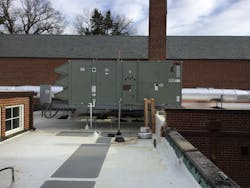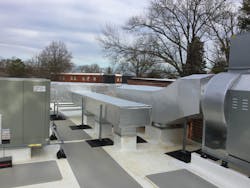Outdated to Optimal
By Paul Tse
ALEXANDRIA, VA -- The Virginia Theological Seminary is the largest of the accredited seminaries of the Episcopal Church. Founded in 1823, the co-ed facility prepares students for their future church careers, as ordained or lay ministers. The main buildings housing the Virginia Theological Seminary were constructed in the early 1950s. Shapiro & Duncan was brought in initially to assist with the renovation and modernization of key spaces on the campus, including the refectory and dining spaces.
Due to the historic nature of the facility itself, the Virginia Theological Seminary project required the Shapiro & Duncan team to tap into its network of seasoned craftspeople and technical experts to address renovation needs in modernizing existing, outdated systems originally in place. The project itself quickly became a journey through historic structural elements with several “teachable” moments along the way as the modernization process unfolded.
A Multi-Faceted Execution Strategy
From the outset of the project through to its completion, the historic nature of the Virginia Theological Seminary facility, as well as the unique elements and processes required to address them, pervaded Shapiro & Duncan’s approach and execution. In the pre-construction phase the team made the choice not to use BIM technology, but instead to rely on comprehensive field surveys to assess the condition of existing structures prior to the start of the construction work.
Shapiro & Duncan’s team began the project with demolition, including cut, cap, and make safe existing pipe systems to eliminate water intrusion events as the renovation progressed. New grease hoods for exhaust air and grease traps on waste lines were installed in the Virginia Theological Seminary’s refectory to meet current building codes for the environment, safety, and function.
In the installation phase, as modernization efforts continued, the Shapiro & Duncan team encountered a structural issue with the building’s existing roof joists which were not sufficient to support the system updates outlined in the renovation plans. As a result, the general contractor partner on the project worked with Shapiro & Duncan to coordinate bringing a structural engineer out to the site, who recommended a complete replacement of the roof, setting the project timeframe back 45-60 days.
Unique Elements Adding to the Construction Process
The Virginia Theological Seminary project required a thorough renovation of the Seminary’s refectory and dining spaces, particularly to update its kitchen, in order to restore them to optimal modern function. In addition to its outdated kitchen, the building was experiencing air flow issues and needed comprehensive architectural updates, including paint.
As the Shapiro & Duncan team got underway with the construction process, a number of challenges arose largely owing to the building’s historic nature. The key ones included:
· Discovery of original terracotta piping below grade. The Virginia Theological Seminary buildings had terracotta piping still in place dating back to its original construction more than 70 years ago. As codes and plumbing methods have significantly evolved over the decades, this dated terracotta material presented a number of challenges, the first being that many members on the project team, even more senior plumbers, were too young to have any experience working with these types of pipes. This required the Shapiro & Duncan team to bring in seasoned plumbers with the background in older materials, like terracotta, to assess and advise the team on removal methods as the renovation process continued to progress. The teachable nature of this part of the project is an extension of Shapiro & Duncan’s overall approach, to support and nurture learning and career development while also executing successfully on client projects.
· Historic hiccups. Also due to the age of the building, the project team decided to survey renovation spaces and prepare accurate plans to guide the project activity using a manual approach and in so doing, encountered some additional challenges along the way, including roof joist issues, also occurring as a result of the age of the building overall.
Through all of the obstacles that arose along the way, a creative approach and ability to leverage a network of seasoned experts were critical elements to the successful achievement of project goals throughout.
Top Results and Timely Completion
The Shapiro & Duncan team’s leadership was an essential element in ensuring timely completion of the project and efficient handling of challenges that arose throughout. The team effectively balanced forging ahead on key tasks--even when the additional job of replacing the roof and joists arose mid-project--to limit the amount of time added to the initial schedule as much as possible.
While the majority of curveballs in this project came as a result of the building’s age and original systems that required additional expert consultation and repair, Shapiro & Duncan’s team was successful throughout in managing activities to keep the project on an even keel.
When embarking on a renovation project involving a historic building, it’s important to invest your time in the project upfront, do your research properly on existing conditions, and ensure you have a network of seasoned experts to call upon in the case of unforeseen issues arising.
Paul Tse is a Senior Project Manager at Shapiro & Duncan, Inc, the Washington, D.C. metro area’s leading provider of cutting-edge mechanical engineering and construction solutions

